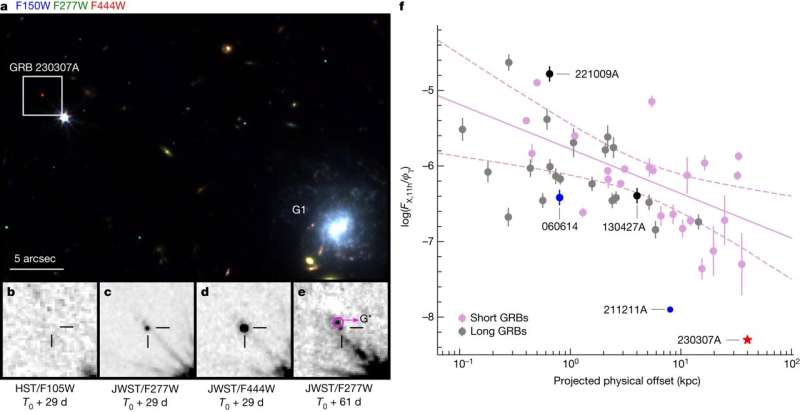February 26, 2024 report
This article has been reviewed according to Science X's editorial process and policies. Editors have highlighted the following attributes while ensuring the content's credibility:
fact-checked
peer-reviewed publication
trusted source
proofread
Further study of bright gamma-ray burst GRB 230307A shows it was caused by neutron stars merging

An international team of astronomers and astrophysicists has found evidence that the bright gamma-ray burst GRB 230307A observed last year was caused by two neutron stars merging, not from a collapsing massive star. In their study, published in the journal Nature, the group analyzed data from both the Hubble Space Telescope and the James Webb Space Telescope.
Prior research has shown that the strongest occasional flashes of light in the night sky are made by gamma-ray bursts. There are two basic kinds of GRBs: those that last longer than two seconds and those that are shorter. Study of these bursts has shown that the shorter bursts are typically the result of merging neutron stars. Longer bursts, on the other hand, were believed to occur when a massive star collapses.
Neutron stars are created when massive supergiant stars collapse during a supernova. Once created, they can wander aimlessly alone through space. Sometimes, though, they travel close to another neutron star, forming a neutron binary system. As they orbit one another, they release gravitational waves, which can be measured here on Earth.
As they spiral, they are also pulled more tightly to one another until they eventually merge, emitting a massive burst of gamma rays, which on Earth looks like a bright burst of light—such bursts are called kilonovae. In studying GRB 230307A, researchers found that not only had it had been the source of the second-largest gamma-ray burst ever recorded, but it was also due to a kilonova, confounding theories regarding how GRBs are created.
As part of their research, the team studied the events leading up to the merger, the merger itself, and the material left after the collision—the first study of its kind. In focusing on the atomic nuclei left behind after the collision, the researchers found evidence of the creation of several heavy elements, including gold and silver. Further study of how such elements were formed, they suggest, could help to better understand how the universe as a whole was formed.
More information: Yu-Han Yang et al, A lanthanide-rich kilonova in the aftermath of a long gamma-ray burst, Nature (2024). DOI: 10.1038/s41586-023-06979-5
Journal information: Nature
© 2024 Science X Network



















